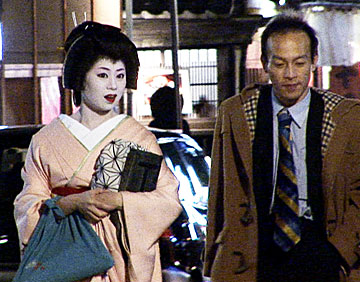
DENNIS CALLAN / SPECIAL TO THE STAR-BULLETIN
In Gion, you can still spot authentic geisha, especially along Hanami-koji street and adjacent side lanes. Geisha and maiko spotted elsewhere will likely be the product of local shops that can transform tourists with elaborate makeup and costuming. Two tourists are shown on the cover (below).
|
|
Homeland of a Geisha
By Dennis Callan
Special to the Star-Bulletin
WITH 4 MILLION VISITORS each year, Kyoto is always popular and even more so now due to "Memoirs of a Geisha," the best-selling novel and new film set here.
For a normal attraction like a city park, amusement arcade or museum, crowds don't matter as much, but the temple gardens here are precious jewels that you should try to view in quiet. Gazing upon a Zen pebble garden alone or with a few others is a completely different experience from jostling in a crowd for a wedge of the best view. Tourist swarms could interfere with a proper appreciation of Kyoto's heavenly gardens, so try to visit during late fall or early spring. Temperatures will be nippy, many trees will lack leaves and garden colors are more subdued, but the absence of crowds makes those trade-offs worthwhile. Late March offers fresh air scented by spring flowers before the stampede of cherry blossom viewers arrive.
Even if you cannot visit during ideal conditions, Kyoto is a four-season destination.
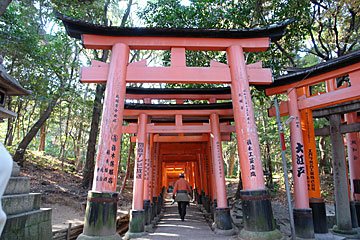
DENNIS CALLAN / SPECIAL TO THE STAR-BULLETIN
Fushimi Inari Shrine is notable for its line of several thousand torii gates that form a two-mile tunnel.
|
|
If you don't mind crowds, consider the peak seasons of cherry blossom viewing in April and colorful foliage in November, or arrange your itinerary to coincide with one of the major festivals. Minimize interference by visiting major sites early or late in the day, and try to avoid the national holiday periods when the city is jam-packed. These include New Year week, a mid-April school break, Golden Week in early May,and O-bon in late August.
Maybe you haven't thought much about Buddhist temples or Shinto shrines, and perhaps never had them on a priority list of must-see places, but visiting this city is different. It's all about the harmony of the gardens and their relationship to the venerable wooden structures that meld into a delightful experience. Nature lovers will gain high value from the effort and those with a spiritual bent can gain much from a visit.
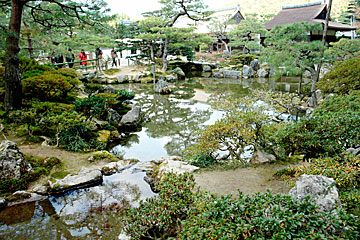
DENNIS CALLAN / SPECIAL TO THE STAR-BULLETIN
Ginkaku-ji, one of Kyoto's most beautiful temple gardens, is best enjoyed early in the day, before the busloads of tourists arrive.
|
|
Kyoto has 17 places listed as UNESCO World Heritage Sites, and other seven attractions including day trips to such nearby cities as Nara. Time can also be spent admiring pottery, fabric, tea ceremonies, flower arrangements, dance, cuisine and calligraphy, all highly developed here.
You can visit many of the major attractions and experience the essence of Kyoto in two days, or you could stay a week and never run out of worthwhile attractions in this former imperial capital of 2,000 temples and shrines.
Temples and gardens: Kyoto is surrounded on all sides by numerous temples, shrines and gardens within a few miles of the town center. A reasonable two-day strategy for dealing with this array is to focus attention in one direction, on Kyoto's east side (Higashiyama) which has a high concentration of sites nestled in lovely, hilly topography.
Many of these sites are within walking distance of each other, reaching about 4 miles from the south to north end of the cluster, which you can comfortably cover in a two-day period. When you add the amount of walking within each site and time spent shopping along the approach lanes, the combined distance could reach more than 10 miles, so you will want to use buses, the subway and taxis. A two-day pass for bus and subway costs 2,000 yen ($18), but if time is an issue you will find taxis much easier, especially on our second-day itinerary.
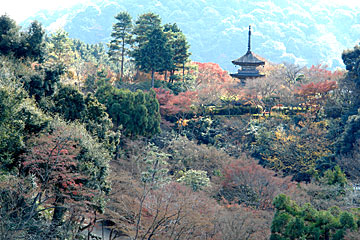
DENNIS CALLAN / SPECIAL TO THE STAR-BULLETIN
From the vast wooden terrace of the Main Hall at Kiyomizudera, you will have a grand view across all of Kyoto.
|
|
Start out in the southeast quadrant at Fushimi Inari Shrine, one of the only sites open 24 hours daily. Arrive early and walk through this phenomenal lineup of several thousand torii gates forming a magical two-mile tunnel through the forest. The shrine is easily reached from the town center by train on either the JR line, stopping at Inari station, or the Keihan Line to the Fushimi Inari station.
An easy half-mile walk through a quiet residential neighborhood brings you north to Tofuku-ji. Typical of most Kyoto temples, it is a group of more than a dozen wooden structures in a lush garden, especially famous for Japan's largest Zen temple gate, 65 feet high, and the bright fall colors of maple leaves in the lush gully. Be sure to find the little-known Zen meditation pebble-garden at the Abbot's Hall and linger here a while to absorb the harmonious serenity. Smaller pebble gardens can be found at other temples. True aficionados of this "sekitei" style of pebble garden accented by symbolic clusters of large rocks might want to visit the most famous at Ryoan-Ji temple in Kyoto's northwest outskirts, perhaps at the beginning or end of the day when it is less crowded.
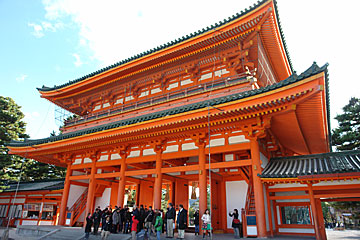
DENNIS CALLAN / SPECIAL TO THE STAR-BULLETIN
Heian Jingu is a reproduction of an Imperial Palace, complete with shrines and a vast garden complex with ponds, islands and Chinese-Japanese-style landscaping.
|
|
The next attraction, Sanjusangendo Temple, is one mile north through busy streets, so it is best to take a taxi (about $5). Sanjusangendo is noted for its collection of 1,001 life-size statues of the Buddhist goddess Kannon including the large statue of Senju-Kannon, one of the world's great sculptural masterpieces. No garden to keep you here longer, so grab a taxi (or bus) and proceed another mile to Kiyomizudera, a beautiful and famous site.
The approach to Kiyomizudera is along a lively shopping lane filled with traditional handicrafts, souvenirs and food that you will want to explore after touring the temple grounds. There are some 30 structures at Kiyomizudera, with the Main Hall classified as a National Treasure. From its vast wooden terrace you will have a grand view across all of Kyoto to the low mountains in the distance.
After exploring the temple grounds, exit along the shopping street that leads to another pedestrian cobblestone lane, Sonnen Zaka, lined with traditional wooden buildings housing shops and restaurants. Here, you might see "geisha" in traditional costume, but they are actually Japanese tourists dressed up that way thanks to several shops providing the service.
Continue walking north one-half mile through a residential neighborhood until you reach Maruyama Park, which has at its center an enchanting pond with a picturesque foot-bridge in the center. There's no need to walk up the gully, but consider having a meal at the traditional restaurant in the small park, serving shojin ryori vegetarian temple cuisine.
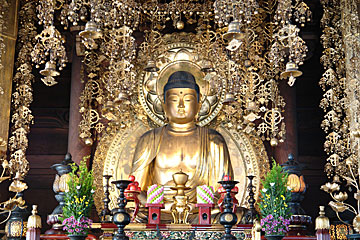
DENNIS CALLAN / SPECIAL TO THE STAR-BULLETIN
At Chion-In, stop to appreciate the huge main hall with its golden altar.
|
|
By late afternoon or early evening, turn your attention to downtown Kyoto, just two blocks west of Maruyama Park, on the other side of Yasakajinja Shrine, another colorful collection of religious structures.
Gion and geisha: Here, in narrow lanes lined with historic wooden facades, you can seek the elusive geisha as she scurries to her next appointment, especially along Hanami-koji street and adjacent side lanes. It is unlikely you will get into a club where the geisha work for it is very expensive, there is a language barrier, and foreigners are discouraged, but if you just wait around, you will certainly see some of these lovely ladies walking quickly by.
Geisha apprentices, called maiko, are equally beautiful in their elaborate makeup and rich kimonos with red collar lining indicating their understudy status. Unfortunately, with the new craze for geisha inspired by the movie, there will probably be many camera-toting tourists prowling this zone, looking for the perfect shot, which is yet another reason to visit during the off-season.
While the main geisha area of Gion is south of the busy Shijo-dori commercial artery, be sure to walk three blocks north along Kiri-doshi to reach the charming little canal that winds it way above and below Shinmonzen-dori, another quaint street. This historic zone extends another block across the Kamo River toward downtown along Pontocho-dori, a pleasant, narrow pedestrian lane of bars and restaurants. Avoid the sleazy red-light district another block west, bright with garish neon.
Modern Kyoto: Downtown Kyoto is appealing with a busy, modern shopping area and thousands of local residents filling the sidewalks. It is a great spot for people-watching, especially lively in the early evening after work. Travelers often find it worthwhile to delay dinner and catch the passing stream of faces, particularly on the busy commercial street, Shijo-dori, and the adjacent covered pedestrian shopping lanes of Teramachi and Shinkyogoku.
Day 2
Seven major sites are on today's schedule, so get another early start with a walk on the Philosopher's Path, a delightful one-mile trail along a tiny canal with lush vegetation, especially tranquil at the beginning or end of day. Along the way, stop in to see the free gardens of Honen-in temple, open by 7 a.m. It is small but features an unusual raised sand platform and small bridge across a lovely pond encircled by lush vegetation.
Ginkaku-Ji: Another 10 minutes along the canal brings you to Ginkaku-ji, one of Kyoto's most beautiful temple gardens. Try to arrive when it opens at 9 a.m. to enjoy its tranquility undisturbed by the busloads that are soon to come. A dramatic entry lined by tall hedges leads into another world, a lyrical dreamscape of ponds and statues linked together by exquisite bamboo railings that guide your way. Up and down the hill you go in an hourlong journey.
Finish and return to the real world. The shopping street in front of the garden is one of the best in town, so browse and try some of the tempting free food samples. There is a convenient bus stop, but taxis are better for the quickest boost to Heian Jingu, the next destination one mile away.
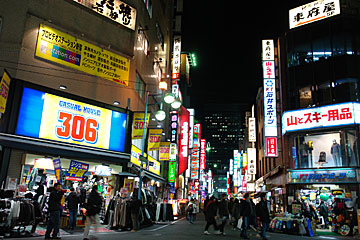
DENNIS CALLAN / SPECIAL TO THE STAR-BULLETIN
In contrast to the historic sites and temples, downtown Kyoto is appealing for its busy, modern shopping areas and thousands of local residents filling the sidewalks.
|
|
This reproduction of an Imperial Palace was constructed in 1895, complete with shrines and a vast garden complex with ponds, islands and Chinese-Japanese-style landscaping. Afterward, walk through the public park in front toward the huge metal torii -- the biggest in town -- and consider a visit to the National Museum of Modern Art, housing a large collection of paintings and ceramics. The Kyoto Municipal Museum of Art is just behind it. A few blocks south you will come to the next temple complex, Nanzen-Ji.
Nanzen-Ji and Chion-In: The large, elevated, stone Sosui aqueduct might look like it belongs in ancient Rome but is one of the defining features of Nanzen-Ji, a vast complex with numerous subtemples, gardens and shrines sprawling up a hillside with another pebble garden, hiking trails, torii, waterfalls and a mountain glen. This would take considerable time to fully explore but a brief glimpse at the aqueduct and visit to Nanzen-In may suffice.
In all of Kyoto my favorite place is the small garden of Nanzen-In, perfectly arrayed around a tiny heart-shaped pond spanned by a foot bridge, accented with rugged rocks and graced with a traditional wooden subtemple. Like many of Kyoto's gems, this garden is not easy to find due to inadequate signage and non-English speaking staffing, but look for the ticket window a few hundred feet downhill from the aqueduct.
If you are so clever and affluent to be staying at the Westin Miyako, you can take a break at this spectacular hotel, the best in town. Otherwise, gambare (persevere) to Shoren-In and the adjacent Chion-In, two more temple-garden complexes.
By now you might even be growing a bit weary of the sensory overload: Have a look at the towering wooden structures, then move along. At Chion-In be sure to appreciate the mammoth Sanmon gate, the largest in Japan, and the huge main hall with its golden altar. One of Japan's most breathtaking statues is next door in a wooden subtemple -- a serene, 10-foot tall golden Buddha.
There are many more attractions waiting to be discovered in Kyoto if you can find the time.
Dennis Callan is president of the Hawaii Geographic Society and frequently leads tours through Europe, Canada and the USA. He produces the "World Traveler" TV series airing at 8:30 p.m. Saturdays on 'Olelo, channel 53. He writes "Three Days in ..." for the Star-Bulletin the first Sunday of each month explaining how to get the most out of the world's great places in carefully planned walking tours. All the articles can be found at
http://www.tourvideos.com.

